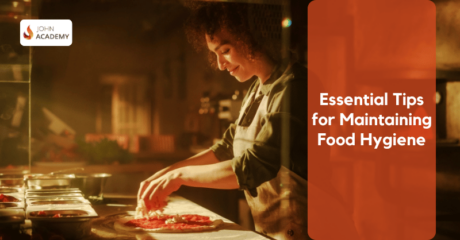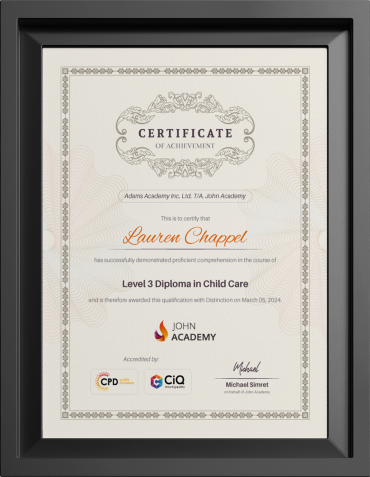
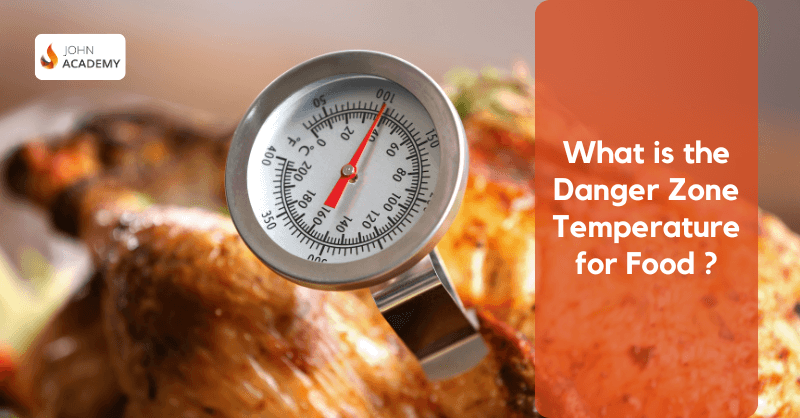
According to WHO, maintaining safe food temperature is one of the five core principles of food safety. This is because harmful bacteria can grow and spread rapidly at danger zone temperatures. Consuming bacteria-infested food can lead to many life-threatening diseases. So, when it comes to food safety, avoiding danger zone temperature is one of the major factors you should look out for.
Table of Contents
What is the Danger Zone Temperature for Food?
The ‘Danger Zone Temperature’ indicates a temperature range where food is dangerous for consumption. This temperature zone is perfect for harmful bacteria to grow and multiply, posing a great health risk. According to the Food Standards Agency, 8 °C —63 °C is considered the danger zone for food.
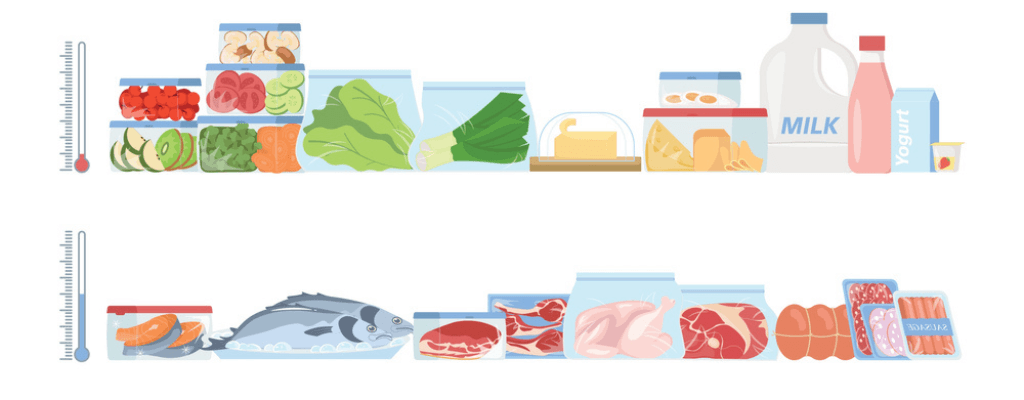
When food is kept between this range, bacteria like Salmonella, Campylobacter and Listeria grow and spread rapidly. Therefore, food stored below 8 °C or heated over 63 °C is the safest to consume. When the food is frozen or chilled under 8 °C, the cold temperature prevents the growth of bacteria.
On the other hand, all germs and bacteria are killed in food that has been cooked or reheated beyond 63 °C. Bacteria require warm places to grow; thus, 20 °C to 50 °C is the ideal breeding temperature for bacteria. Therefore, maintaining the temperature for storing and cooking food is vital to prevent bacteria and other harmful germs.
What are the Risks of Consuming Food Stored at Unsafe Temperatures?
Food provides us with the nutrition we need to sustain our lives. However, the same food can become a threat due to many factors, and temperature is one of the major ones.
When the food reaches the temperature zone between 8 °C and 63 °C, pathogens start to grow. These pathogens may include E.coli, Salmonella, Listeria and many more. Consuming food infested with pathogens can seriously damage your health. Vomiting, diarrhoea, stomach pain and nausea are some of the symptoms. Sometimes, the symptoms can cause severe complications like food poisoning and even death.
Mould is another threat when food is kept in unsafe temperatures. The ideal temperature for mould growth on food is 25 °C to 30°C. This temperature is ideal for mould to grow and multiply rapidly. These moulds possess mycotoxins, which can cause allergic reactions, respiratory problems, vomiting, diarrhoea, etc. In addition, you have to throw away the food when there is mould. As a result, it increases food spoilage and waste.
That’s why we recommend Food safety training. Ensure Your Food Safety Today!
Who are At-risk Populations?
Consuming unsafe food is risky for everyone. However, for certain groups of people, the consequences can be more serious. Those who are prone to serious risks are –
- Elderly people
- Children
- Pregnant women
- People who have weak immune systems as a result of illness or medications
How to Keep Food out of the Danger Zone?
There are many strategies that will help you keep your food out of the danger zone temperature. We have compiled some effective tips to help you out. Here they are –
Cook the Food Thoroughly
In order to keep the harmful bacteria and germs at bay, you must follow the temperature guidelines for cooking. Make sure the internal temperature of the food reaches more than 70 degrees Celsius. It is vital for killing all the bacteria and germs lurking in the food. If you are cooking poultry, the internal temperature should be around 74 °C. However, if you are cooking beef, lamb, or other meat, the temperature should be 63 °C with three minutes of rest time.
Using a kitchen thermometer is the best way to ensure the food reaches the right temperature. As an extra precaution, you can also keep a danger zone temperature chart in your kitchen.

Store and Reheat Food Properly
Cooking safely is not enough, as bacteria can grow on cooked food as well. Therefore, the perfect temperature for storing food in the refrigerator is 4 °C. At this temperature, there is less risk of food contamination, and bacteria can not grow in such cool temperatures. Furthermore, you should keep your food in sealed containers to avoid contamination. Also, keep track of the temperature of your refrigerator to avoid any food safety issues.
When you want to freeze the food, ensure your freezer is at around -18 °C. The low temperature will prevent pathogens and keep your food safe.
When the food is not reheated properly, it is more prone to bacteria growth and contamination. So, while reheating food, make sure it’s piping hot and heat is evenly distributed. The ideal temperature for reheating food is 70 °C, as it is adequate for killing the germs.
Maintain Safe Temperature while Defrosting or Thawing
The defrosting and thawing process requires temperature change. Therefore, there is a high risk that food will reach the danger zone and may stay there for a while. So, the best way to avoid this is to defrost food and keep it at a cool temperature in the fridge.
You can keep the frozen food overnight in the refrigerator and it will do the work. You can also defrost or thaw food in the microwave or give it a cold bath. But you should never leave it out at room temperature, where it can reach the danger zone. Also, after thawing, don’t wait up; Cook it immediately.
Recommended Reading
Hot-Holding
Hot-holding refers to the process of keeping food above the danger zone temperature. This will come in handy when you do not plan to eat the food immediately after cooking. You can use chafing dishes, slow cookers, and warming trays to keep the temperature above 63 °C or higher. Keep in mind you have to control the temperature while using hot-holdings as there is a risk of overcooking the food.
What is the Temperature Danger Zone for Bacterial Growth?
Bacteria need a warm temperature to grow and multiply. Thus, the ideal temperature ranges from 8 °C to 63 °C. However, in certain temperatures, they thrive the most and this optimal temperature varies according to their type. Here is a list of some of the common food pathogens and their optimal temperatures
Salmonella
Mostly found in raw poultry and meat, the ideal temperature for these bacteria is 37 °C. However, it can also grow between 5 °C and 47 °C.
E. coli
Undercooked meat, raw milk, raw vegetables, etc., are breeding grounds for E. coli. It can grow from 7 °C to 50 °C and thrives at 37 °C.
Listeria
30 °C is the ideal temperature for the growth of this bacteria. However, it has the ability to grow between 1 °C to 45 °C. You can find Listeria in ready-to-eat meat, refrigerated foods etc.
Clostridium
Between 43 °C and 47 °C, Clostridium perfringens bacteria can grow on meat, poultry, and other types of food. On the other hand, Clostridium botulinum grows and multiplies the most at 35 °C and 37 °C. Usually, it grows in improperly canned and vacuum-packed foods.
Campylobacter
You will find Campylobacter in raw poultry, unpasteurised milk, and contaminated water. The optimal temperature for it to grow is 42 °C, but it can also grow between 30 °C to 45 °C.
How Long Should You Cook Food for?

The cooking time for your food depends on the type of food and cooking method you are using.
In a more general sense, your cooking time depends on how long it takes to reach the safe temperature zone, which is 70 °C. It is equally important to ensure that after reaching 70 °C, the temperature remains the same for at least 2 minutes. Also, check if the thickest part of the food reaches the temperature. If the heaviest part is 70 °C or above, your food is pathogen-free.
Here are some basic foods and the temperatures at which you should cook them.
What is a Temperature Danger Zone Chart?
The temperature Danger Zone chart is a visual guideline that demonstrates the temperature range ideal for bacterial growth. In addition, the chart provides information about the ideal cooking temperature and safe storage zone. This chart plays a pivotal role in minimising the potential for bacterial growth and ensuring food safety.
You can download and print the chart to put in your kitchen for more effective use. We have prepared a chart for you; all you have to do is download and print it!
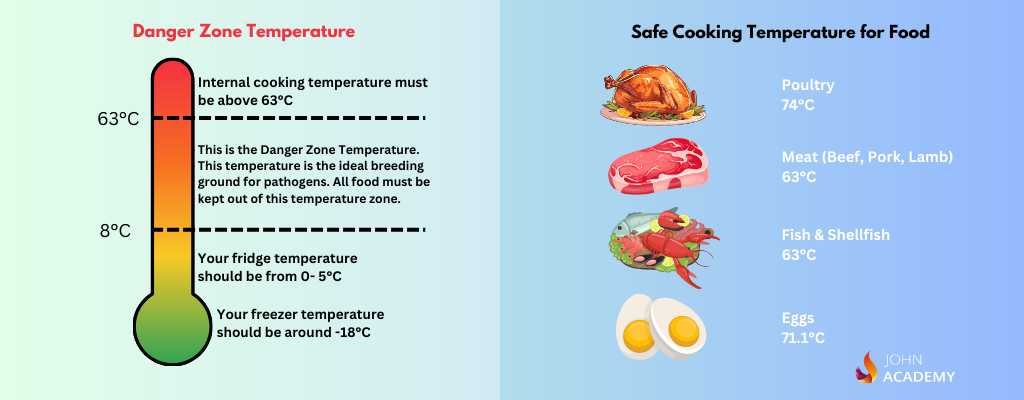
How Long can You Keep Food at Danger Zone Temperature?
It is advised not to keep food in the danger zone. However, sometimes, for cooking preparation or other reasons, you may have to keep the food out for a while. In such cases, you should follow the 2-hour/4-hour rule. The goal of this rule is to help people determine whether the food left in the danger zone is safe to consume or not.
When food is kept within the danger zone range for less than 2 hours, it is still safe to consume. You can also put it in the refrigerator and store it for later use. If the food was in the danger zone for more than 2 hours but less than 4, you can still consume it. However, you have to eat it immediately, and you can’t put it in the refrigerator.
On the other hand, if the food is kept for more than 4 hours, you should not consume the food at all. When more than 4 hours have passed, it is not safe and should be thrown away. By following this rule, you can ensure food safety and reduce the risk of foodborne illnesses.
How to Check Food Temperature?
As you already know, maintaining food’s temperature is pivotal for food safety. Most of the time, people use the colour to determine if the pathogens are cleared or not. However, this is not an accurate method, as the colour can change before the pathogens are killed.
Sometimes, people also check for ‘Doneness’ to ensure the food reaches a safe temperature. ‘Doneness’ refers to the taste, texture and appearance of the food. But it is highly possible to overcook the food and lose the taste while looking for signs of ‘Doneness’.
Therefore, the most reliable way to maintain the temperature is through a thermometer. A thermometer will not only tell you the temperature but also help you understand if the food acquired the desired taste and texture. So, use a thermometer while cooking to ensure a safe temperature and the best taste

There are different types of thermometers with different mechanisms and prices. Here is a list of kitchen thermometers you can find in the market.
Things You Should Remember While Using a Kitchen Thermometer
While using a Kitchen thermometer, you should consider a few factors to get the optimum results. These factors include –
Place the Thermometer in the right place
Placing the thermometer in the right place is crucial for getting an accurate reading. To get the correct reading of the whole food, you have to insert the thermometer in the thickest area. In addition, make sure you place it in an area without any bone, fat, or cartilage.
Check the Instructions
After you get your thermometer, check the instructions in the packaging for more effective results. The instructions will tell you which part to insert in the food and how far to insert it. The usage process and how the readings are shown will differ from one type of thermometer to another. That is why reading the instructions is important.
Wait a While
For accurate results, you should wait to stabilise the thermometer. This will help it provide a more consistent and accurate number. Especially if you are cooking a big chunk of meat, you need to wait a bit to get the right temperature. For some thermometers, like oven-safe thermometers, you have to leave it in the food and track the temperature as the food gets cooked.
Clean-up
It is mandatory to clear the thermometer before and after using it to avoid contamination. Bacteria, germs, and mould can grow on a dirty thermometer and contaminate your food. In addition, it increases the risk of cross-contamination. That’s why it’s important to clean up your thermometer.
Safe Temperature for Various Types of Food
Generally, the safe temperature zone for food is above 63 °C and below 8 °C. However, the ultimate safe zone food may differ according to the type of food. Here is a chart of some common foods we consume daily and their safe internal temperature.
Food Safe Internal Temperature Poultry 74°C Ground Meet 71°C Beef, Lamb, Pork 63°C Fish & Shellfish 63°C Leftovers 74°C Eggs 71.1°C
Some High-risk Foods
There are many factors behind food becoming a threat. However, in some food, pathogens can easily grow and spoil the food. Therefore, they pose a higher risk than other foods. These high-risk foods include –
So, we must be cautious when consuming these foods and follow the right temperature controls.

Summary
When it comes to food safety, many people ignore the impact of temperature. However, avoiding the danger zone temperature for food is crucial to ensure food safety. Therefore, whether you are a home cook or a culinary professional, give utmost attention to temperature along with other food safety principles. It will help you provide safe and delicious meals to your customers or loved ones.
FAQ
According to the 2-hour/4-hour rule, food is kept in the danger temperature zone for less than 2 hours you can eat or store it in the refrigerator.
- If it’s more than 2 hours but less than 4, you can still consume it.
- If 4 hours have passed, then you should throw away the food.
No, if the meat is out for a long time, there is a high chance of bacterial growth. Therefore, it is not safe to consume.
To ensure all the bacteria are killed, you should cook poultry till it reaches 74°C.
A low temperature is used to cook food in the smoker. Thus, when meat is in the smoker, it takes a while to defrost and cook the meat. As a result, the meat stays in the danger zone for a while and increases the risk of bacterial growth. It is suggested that the meat be thawed overnight in the refrigerator before cooking it in the smoker.



